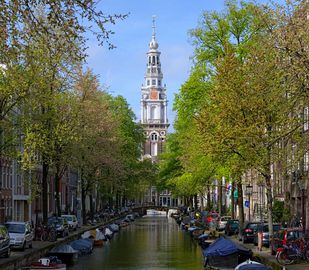

Zuiderkerk, or The South Church was the city's first church constructed specifically for Protestant services, namely as a Dutch Reformed Church. It was erected between 1603 and 1611 and is located on the Zuiderkerkhof Square off the Sint Antoniesbreestraat. The distinctive church tower rises above the surrounding area and can be spotted from as far as Rembrandtplein and Waterlooplein. It is one of the most beautiful structures in Amsterdam and it offers fine panoramic views from its balconies. The tower was not completed until 1614 and contains a carillon of bells built by the Brothers Hemony and installed 50 years later. The bells are played weekly on Thursdays between noon and one and can be listened to from the square outside.
The church was built in the Renaissance style after the design by Hendryk de Keyser , who was appointed the city's stone mason and sculptor in chief architect in 1594, and chief municipal architect in 1612. De Keyser is also credited with designing other important Amsterdam landmarks such as the East India House and, what's probably his greatest building, the Westerkerk (West Church) built in the middle of 17th century. The celebrated architect was buried in the Zuiderkerk. De Keyser designed the church as a pseudo-basilica in Gothic style with a central nave and two lower side aisles, six bays long, with Tuscan columns, timber barrel vaults and dormers. The stained glass in the rectangular windows was replaced by transparent glass in the 17th Century.
The church, given its picturesque and finely detailed character was an inspiration to many artists, among them the renown French Impressionist Claude Monet, who painted the church in 19th century, and Oskar Kokoschka, the Austrian/German Expressionist, who had done the same in the 20th century. Rembrandt lived in a stately house just over the bridge, and three of his children were buried in the Zuiderkerk. Ferdinand Bol, Rembrandt's most famous pupil, was also buried in the Zuiderkerk in 1680. According to the local legend, Rembrandt was painting the Night Watch in the Zuiderkerk, because the studio in his house could not accommodate the enormous canvas which now occupies an entire wall in the Rijksmuseum. However, the truth of this story is highly disputed. Another legend has it that this church greatly impressed the great British architect Sir Christopher Wren, London’s famous architect who built the St. Paul’s Cathedral and many of London's other churches.
The Zuiderkerk was used for church services up until 1929. During the final winter of World War II, known as the Hunger Winter of 1944-45, the church served as a temporary morgue because people were dying of hunger and cold faster than they could be buried. In 1970 the church was closed because it, along with many other historic buildings in this neighborhood, was on the point of collapse. Being a great landmark and a monument it was not condemned for demolition, as many other buildings surrounding it, and in the 1970s underwent thorough renovation. Since 1988 it serves as the municipal information centre on housing and environmental projects, with regularly changing exhibitions.